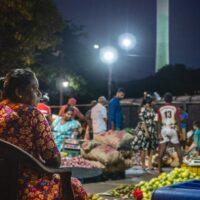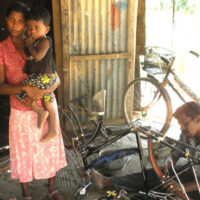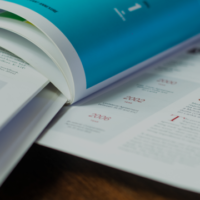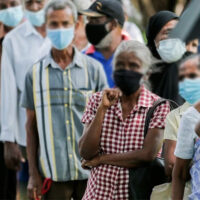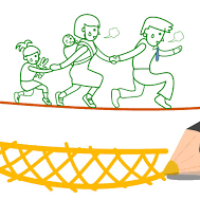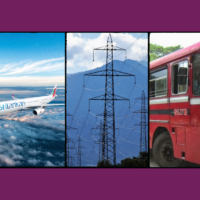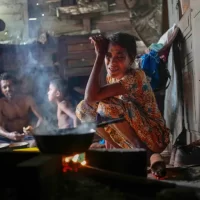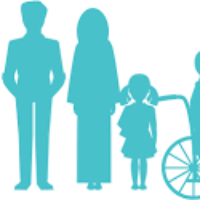A Rapid Appraisal of the ‘Aswesuma’ Social Benefit Scheme
Dr. Hemesiri Kotagama
“Overcoming poverty is not a gesture of charity. It’s an act of justice. It is protection of a fundamental human right, the right to dignity and decent life”.
Nelson Mandela
Summary
- ‘Aswesuma’ provides benefits to a lesser number of families than Samurdhi despite a substantial increase in poverty in Sri Lanka due to economic crisis. (It must be noted that this is even after corrections for inclusion and exclusion errors in Samurdhi were done)
- The change from Samurdhi to Aswesuma has caused a larger drop of beneficiary % in the estate sector (15% drop) than in the rural sector (9% drop), despite the estate sector having much higher poverty levels.
- The Multidimensional Poverty Indicator although is expected to capture more poor people, has captured less poor people (particularly in the estate sector).
- The selection method earlier (Samurdhi) was considered flawed; but the Multidimensional measure (Aswesuma) is no better, as the poverty score estimation dimensional weights and poverty cut-off score is unknown to the public.
Introduction: The ‘Aswesuma’ Social Benefit Scheme was the substitution of the ‘Samurdhi’ Social Benefit Scheme. This substitution was insisted upon as a necessary condition to be fulfilled by the Government of Sri Lanka, in the loan agreement with the International Monetary Fund (2023). The reasons for the change are:
- Poor targeting: It is alleged that inefficiency prevailed in the Samurdhi program on errors of inclusion of unwarranted beneficiaries and exclusion of warranted beneficiaries. The exclusion error has been such that in 2006, more than 50% of the 20% of lowest-income earners of the population benefited from Samurdhi, and by 2019, that had declined to 38%. The inclusion error has been such that according to the 2019 data, 12% of the richest 20% income earners had been receiving Samurdhi benefits (IMF, 2023; World Bank, 2022). LIRNEasia Institute, on 07, June, 2023 reported based on an island wide survey of 10000 households, that of the poorest 10% of families in society, only 31% received Samurdhi benefits. Of the richest 10% families, 4% benefited from Samurdhi!!!
- Inadequacy of allowances: In 2019, social assistance in Sri Lanka represented 12 percent of the beneficiary pretransfer consumption, which is lower than the average of low and upper middle-income countries at over 30 percent (World Bank, 2022).
The changes from Samurdhi to Aswesuma are primarily in the process and method of identifying the poor, as explained in gazette No 2302/23, 20/10/2022, and amounts to be paid to beneficiaries in gazette No 2328/13, 21/04/2023). In essence, the poor beneficiaries are identified using an objective process on a quantified multidimensional indicator of poverty. The total amount to be transferred to the Aswesuma beneficiaries is Rs 206 Billion.
As at 22nd June 2023, the change has been done from Samurdhi to Aswesuma. The names of Aswesuma beneficiaries have been published publicly, open for grievance applications (https://iwms.wbb.gov.lk/).
This article is a rapid appraisal of the Aswesuma scheme in comparison to the Samurdhi scheme. Two Grama Niladhari Divisions (Rookwood Estate and Rikillagaskada) were purposely selected from the Hanguranketha Divisional Secretariat Division and Nuwaraeliya District. The two Grama Niladhari Divisions were selected, one to represent tea estate community /sector (highest poverty sector) and the other rural village community/sector (see Table 1). The two Grama Niladhari Divisions are rather spatially close by and the population size too is comparable. All data for the analysis was obtained from Sri Lankan government websites.

The expectations/hypothesis, analysis and conclusions:
- Does more poor benefit from Aswesuma than from Samurdhi during an economic crisis?
According to the agreement between International Monetary Fund and Government of Sri Lanka:
“The number of beneficiaries increased by about 40 percent from 2.3 million in 2019 to about 3.3 million in 2022 (with economic crisis). Preliminary evidence suggests that this emergency support (partly supported by Asian Development Banka and World Bank) helped mitigate the impact of the crisis on the poor and vulnerable. For instance, the scaled-up SSN (Social Safety Net) transfers are estimated to have had a poverty-reducing impact of 3.1 percent in 2022, meaning that the poverty rate would have been 28.7 percent, compared to the current projection of 25.6 percent (World Bank, 2022, pg. 73)”.
“The total number of beneficiaries initially (Aswesuma) are expected to remain at around 3.3 million (the same level as at end-2022). Under the new criteria, the composition is expected to improve owing to lower inclusion and exclusion errors for all SSN programs (IMF, 2023, pg. 76)”.
However, according to gazette No 2328/13, 21/04/2023 only 2 million people would receive Aswesuma and a further 527,817 people would receive Payments for differently-abled persons, chronic kidney disease of unknown etiology (CKDU), elderly beneficiaries (both together about 2.5 million people). Thus, the expectations of 3.3 million people receiving Aswesuma, as per agreement between International Monetary Fund and government of Sri Lanka have not been met. This violation of the agreement is corroborated by this rapid appraisal.
Given the national economic crisis that has raised the poverty levels, it is expected that more poor would benefit from the Aswesuma scheme than the Samurdhi scheme. This is expected despite the removal of the unwarranted beneficiaries in the Samurdhi scheme (see below for analysis). Due to the economic crisis in Sri Lanka, the poverty rate has more than doubled. Internationally, the poverty rate is defined as what percentage of the population earns less than $3.65 a day. Based on this measure, the International Monetary Fund (2023) has estimated that the poverty rate has increased from 11.3% to 25.6% in 2022. LIRNEasia Institute, in a survey of 10,000 households representative of the country, found the poverty rate to be 31% (07, June, 2023).
Table 2 provides a comparison of % of receivers of Samurdhi and Aswesuma. Recipients of Samurdhi are reported in families and recipients of Aswesuma are reported by individuals. Comparison would not be erroneous as the average family size in the two Grama Niladhari Divisions are the same, 3.9 members/family.
Despite expectations of increased poverty rates alluded to the economic crisis, the Aswesuma provides benefits to less of the population than Samurdhi.
The table indicates that in Rookwood, 27% of the families received Samurdhi which has declined to 12% receiving Aswesuma; and in Rikillagaskada, 15% of the families received Samudhi which has now declined to 6% receiving Aswesuma. Even on correcting for errors of inclusion and exclusion of the Samurdhi scheme, given the unprecedented increase in poverty due to the economic crisis (particularly near poor) Aswesuma was expected to benefit more individuals than Samurdhi.
The national multidimensional poverty indicator is more (18.8% head count) than the monetary indicator of poverty (14.8% head count) as of HIES (2019), indicating more poor people should benefit from a multidimensional poverty measurement as done by Aswesuma apart from the reality of increased poverty in the country. The % of Aswesuma beneficiaries are less than the national average poverty measures for both estate and rural sectors, whilst Samurdhi scheme was consistent with the national poverty estimates. This, whilst admitting the limited scope of the sample taken for this rapid appraisal, leads to suspecting the validity of the Multidimensional Poverty Indicator or its data collection to identify Aswesuma poor beneficiaries. Further formal inquiry is required to validate the multidimensional poverty measure.
As expected the more estate sector families as a % have received benefits than the rural sector, in both Samurdhi and Aswesuma schemes.

- Do corrections for inclusion and exclusion errors of Samurdhi warrant a decrease in poor beneficiaries through Aswesuma?
According to IMF 2023, quoting World Banka (2022):
- In 2006, more than 50% of the 20% of lowest-income earners of the population benefited from Samurdhi, and by 2019, that had declined to 38%.
- And according to 2019 data, it is revealed that 12% of the richest 20% income earners are receiving Samurdhi benefits (World Bank, 2022).
- LIRNEasia Institute, 07, June, 2023 reported based on island wide sample of 10000 households, that of the poorest 10% of families in society, only 31% receive Samurdhi benefits. Of the richest 10% families, 4% benefit from Samurdhi!!!
Table 3.a provides estimates of the number households that should receive Samurdhi benefits by reducing inclusion errors of 12% and adding the exclusion errors of 50% as claimed by the IMF-Sri Lanka loan agreement (2023). Accordingly 36% of the households in Rookwood estate and 20% of the household of Rikillagasakde village should have received Samurdhi. These poverty rates are closely congruent with recent estimates of poverty post economic crisis. The World Bank estimated that poverty increased from the prepandemic rate of 11.3 percent to 25.6 percent in 2022 (IMF, 2023: World Bank, 2022) and LirnASEA (2023) estimated poverty rate as 31% nationally. The decrease in Aswesuma beneficiary recipient to the base of expected Samurdhi recipients on correction for inclusion and exclusion errors is -23% for Rookwood estate and -14% for Rikillagaskade village. Thus it is noted that apart from the drops for both estate and rural sectors, the drop in beneficiary recipients is higher for the estates than village. This is unacceptable given that on national statistics poverty is substantially high in the estate sector.

On the positive aspects of the change, the allowance paid per beneficiary has increased as per gazette No 2328/13, 21/04/2023. The estimated total payment is Rs 206 Billion per annum, whilst the loan agreement between International Monetary Fund and Government of Sri Lanka has set a floor limit of LKR 187 billion in 2023 (0.6 percent of GDP) and to continue to allocate at least 0.6-0.7 of GDP beyond 2023. The continuation of the real amounts allocated would depend on Sri Lanka’s economic growth rate and related economic performance.
- Validity of the Aswesuma Multidimensional Indicator of Poverty Measurement.
Given the nature of dimensions and indicators used in the Aswesuma scheme (Education, Health, Economic level, Assets, Housing Condition and Family Demography) more in the estate sector should receive benefits from the Aswesuma scheme. Most of the education, asset, income level indicators are tilted to be poor in the estate sector than the rural sector. Table 3.b compares aggregate figures of few of the multidimensional measures of poverty used by Aswesuma. It is observed that at least on housing conditions the estate sector is drastically poor. However, in the change from Samurdhi to Aswesuma the drop in beneficiary % in estate sector (-15% drop) is larger than in the rural sector (-9% drop). This again doubts the validity of multidimensional poverty measurement approach adopted by Aswesuma. Despite the alleged improvements in poverty measurement through Multidimensional Poverty Indicators commonsense expectations are not met.

- Why is poverty identification a mystery in Aswesuma?
Whether a household is poor and is eligible to receive Aswesuma is decided on a score (deprivation score) calculated using an Multidimensional poverty equation. This equation and how the poverty score of an individual is estimated is elaborately provided in government gazette (No 2302/23, 20/10/2022). It would enable a household (perhaps with the help of a learned person) to objectively decide whether he/she is eligible to receive Aswesuma benefits, if all weightages on the poverty dimensions and the cutoff poverty scores are made public information. Then the process is transparent and the appeals process clear. One may if legal possibilities prevail, take legal action on the eligibility of receiving Aswesuma. Thus why is some information on identification of Aswesuma beneficiaries is not shared with the public is perplexing.
Conclusion: Despite the alleged improvements in poverty measurement through Multidimensional Poverty Indicators and despite money being made available through the International Monetary Fund loan agreement and World Bank, commonsense expectations are not met, through the change from Samurdhi to Aswesuma. This is an extremely preliminary, indicative analysis (until in-depth analysis is undertaken), the indications are disappointing, to the poor people of Sri Lanka. In essence following are indicated.
- Aswesuma provides benefits to lesser number of families than Samurdhi despite substantial increase in poverty in Sri Lanka, with the economic crisis, even after corrections and for inclusion and exclusion errors in Samurdhi.
- The change from Samurdhi to Aswesuma has caused a larger drop of beneficiary % in estate sector (15% drop) than in the rural sector (9% drop), despite the estate sector having higher poverty.
- The Multidimensional Poverty Indicator although is expected to capture more poor people, has captured less poor people (particularly in the estate sector).
- The selection method of the previous welfare system (Samurdhi) was considered flawed. The Multidimensional measure (Aswesuma) is no better.
References
Department of Census and Statistics (2019) Household Income and Expenditure Survey Report, Sri Lanka.
IMF Country Report No. 23/116 (2023) Request For An Extended Arrangement Under The Extended Fund Facility—Press Release; Staff Report; And Statement By The Executive Director For Sri Lanka, International Monetary Fund.
World Bank, (2022), Sri Lanka Development Update: Protecting the Poor and Vulnerable in a time of Crisis. The World Bank.
Disclaimer: The views expressed in this article are those of the author and do not necessarily reflect the views and policies of CEPA.
